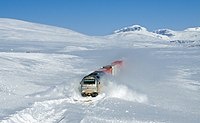
Photo from wikipedia
Abstract Research on the effect of snow on the temperature field of frozen ground is of great significance to the laying of underground oil pipelines, design of roads, and control… Click to show full abstract
Abstract Research on the effect of snow on the temperature field of frozen ground is of great significance to the laying of underground oil pipelines, design of roads, and control of frost damage in cold regions. The heat transport laws of frozen ground with phase changes under periodic temperature boundary conditions were analyzed based on data monitoring in this paper. Based on the boundary conditions determined by the monitoring data, the numerical calculations of frozen ground and subgrade with/without snow cover were carried out, and the effects of snow cover on the temperature fields of frozen ground and subgrade in cold regions were explored. Monitoring results demonstrate that the temperature at different sections of frozen ground with phase change presents a sine-like function under the periodic temperature boundary condition. According to monitoring data, when the thickness of the natural surface snow cover is about 25 cm, the daily average minimum temperature of soil at 0.1 m from the surface will rise by about 10 °C compared to that without snow cover during a year (in a cycle); nevertheless, when combined with numerical calculation, the permafrost table increases by about 2.87 m, and the permafrost base decreases by more than 5.59 m. Under the boundary conditions set in this paper, the permafrost under the subgrade disappears in a greater area due to the construction of the subgrade in the snow-covered area. In addition, the elliptical thawing soil area produced by the lower part of the slope of a snow-covered subgrade will adversely affect its stability.
Journal Title: Cold Regions Science and Technology
Year Published: 2021
Link to full text (if available)
Share on Social Media: Sign Up to like & get
recommendations!